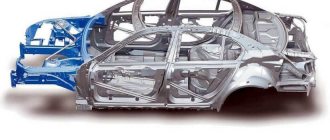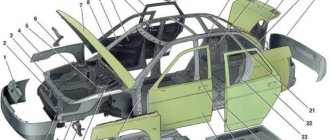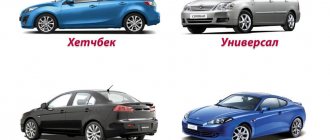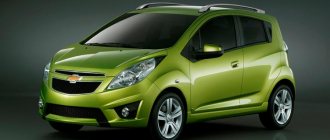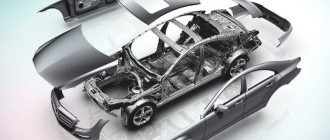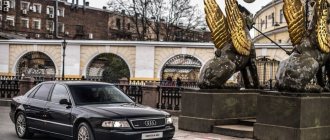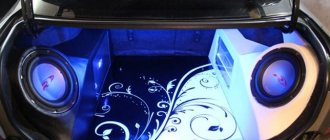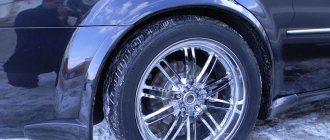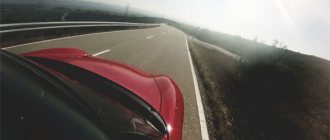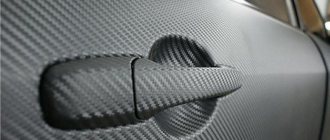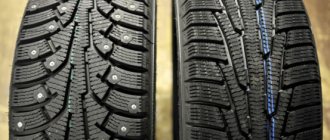Car frame
Vehicle support system
The supporting system serves for installation and fastening of all units and mechanisms of the vehicle.
It absorbs lateral and longitudinal loads, bending and torques transmitted by the vehicle’s engine, transmission and axles, as well as wheels and suspension as a result of the vehicle’s interaction with the road, acceleration and braking.
The supporting system can be a separate element - the frame or the car body itself, therefore all cars are divided into frame and frameless (having a supporting body). There are also frame-body load-bearing systems, which are often used on buses, with the frame and body base combined into one structure.
The following requirements are imposed on the vehicle's supporting system:
- sufficient strength and rigidity;
- stable relative position of vehicle mechanisms;
- high technology during operation and repair;
- minimum weight;
- maintaining the kinematic coordination of the operation of vehicle mechanisms and their performance during bending and twisting of the elements of the supporting system.
Advantages of the frame support system:
- simplicity and reliability of design;
- manufacturability in production and repair;
- versatility (various types of bodies can be installed on the same frame and regular and special vehicles can be produced on the same chassis).
For trucks that have a separate body for cargo and a cabin for the driver and passengers, the frame structure is the most convenient technical solution.
Load-bearing bodies are used on especially small, small and medium-class passenger cars, as well as on most buses.
Advantages of monocoque bodies:
- reducing vehicle weight;
- reducing the height of the car;
- lowering the vehicle’s center of gravity, therefore increasing its stability;
- load distribution throughout the vehicle structure, and not just in the frame.
The disadvantages of monocoque bodies are the complexity of manufacturing and repair, as well as low versatility when used on vehicles for various purposes - even minor changes in the layout of the car require costly changes in the body structure.
Car frame
The frame is the skeleton of the car, i.e. its “skeleton”. It perceives all external and internal loads that arise when the car is moving and even when it is parked - the weight of cargo, passengers and the mechanisms and devices placed on it, as well as moments and forces transmitted by the engine and transmission and chassis units. For these reasons, the following requirements are imposed on automobile frames:
- required rigidity and strength;
- minimum weight;
- a rational shape that allows for a low center of gravity of the vehicle, sufficient travel of the suspension, steering elements and steering angles.
Classification of automobile frames
Frames can be spar and spinal (central). Spar frames, in turn, are divided into ladder and peripheral. A type of spinal frames are X-shaped frames.
Spar frames
Ladder spar frame
The staircase spar frame (Fig. 1, Fig. 2, a) consists of two spars 1 (longitudinal beams), which are interconnected by cross members 2. The spars and cross members have a channel cross-section, with the channel flanges facing inward when assembling the frame. The thickness of the sheet steel from which the side members are made is 5...10 mm. Low-carbon steels, which lend themselves well to cold stamping, are used as materials for structural elements of automobile frames. Sometimes titanium steels are used, which, due to their higher mechanical properties, make it possible to reduce the weight of the frame by 15...20%.
The side members can be parallel or converge at the front of the vehicle to create the free space necessary to turn the steered wheels. In accordance with the load distribution on frames for two-axle vehicles, the largest section of the spar is in the middle part of the frame, decreasing towards the ends of the frame. The variable cross-section of the side members allows you to reduce weight and metal consumption, without significantly reducing the strength and rigidity of the frame. In addition, this configuration of the side members makes it possible to lower the vehicle’s center of gravity, which is important for increasing its stability during curved movement and maneuvering.
To reduce the center of gravity, side member beams in passenger cars and light-duty trucks are often bent over the axles and axles in a vertical plane.
The rigidity of the frame is increased by installing gussets and braces between the side members and cross members. The spars and cross members are fastened together by cold riveting or welding. The widespread use of riveted joints is due to their good resistance to vibration loads. Welded frames are highly rigid, but are more difficult to repair and are less durable in areas adjacent to the welds.
The cross members are attached to the side members flanges and their walls. The locations of the crossbars and the shape of their cross-section (box-shaped, trough-shaped, Z-shaped, U-shaped, etc.) are selected based on the uniform strength of the frame along the entire length.
Cross members must be installed at the mounting location of the spring brackets, engine, gas tanks, and at the mounting locations of the balance spring (for three-axle vehicles), and the spars themselves in these locations are often reinforced with special inserts.
The cross members are stamped from the same sheet steel as the side members. For complex crossbar shapes, highly plastic steels are used. The homogeneity of the metal of frame elements is dictated by the possibility of galvanic currents arising when different metals are used for side members, cross members, rivets and reinforcing elements. Galvanic currents initiate corrosion and can cause other problems during vehicle operation.
Spar frame
This is the most common type. The frame design includes two power longitudinal beams, which are called spars. They stretch along the body and are connected by crossbars. The beams are made of steel. In order to increase twisting performance, various types of section profiles can be used.
The spars are not necessarily straight - sometimes they have both vertical and horizontal bends. They can be located either parallel to the horizontal plane or at a certain angle, which is typical for SUVs. It is also possible to have different arrangements of the cross members, through which the spars are connected. Today it is the most popular frame design, used in most trucks and SUVs.
This frame is perfect for operating the car on bad roads. It also simplifies the repair and assembly of the car. The disadvantages are that the spars take up a considerable part of the interior and somewhat complicate the landing process.
Spar X-shaped
An X-shaped frame is one of the types of spar frames. The peculiarity of its design is that the spars at the front and rear are spread apart, and in the center they are brought together as much as possible. This type is similar in appearance to the “X” beech, which is the reason for its name.
Peripheral
It is a type of spar frames. This type began to be actively used on large European-made passenger cars and “dreadnoughts” from the USA in the 60s. In such frames, the spars are located so widely that during the installation of the body they are located at the sills. This allows the floor level to be significantly lowered, while at the same time reducing the immediate height of the machine.
An important advantage of such a machine is its maximum adaptability to side impacts. However, there is a significant drawback - the frame cannot withstand significant loads, so the car body must have the necessary strength and rigidity.
Car body safety
Modern cars have bodies with a spatial structure that allows them to provide reasonable safety against impacts resulting from collisions from any direction. However, accident statistics show that the most dangerous is a head-on collision. The first official rules for vehicle safety testing appeared about 35 years ago and were written for frontal collisions. Today, side and rear impact protection is required to be assessed. Most car manufacturers conduct their own rollover safety tests.
Characteristic features of the rear body
Steel plates with high reliability parameters are purchased by manufacturers to form the rear side members. Their task is to support the luggage compartment floor, constructed from a stamped sheet, taking on the loads when transporting goods.
The rear wings in the monocoque body structure of the car are not removable, but are tightly welded to the body. Body cups hold the top of the rear pillars. It is worth summing up and highlighting the advantages of load-bearing bodies.
What is a car body and what does it consist of?
A car is made up of many elements that work together seamlessly. The main ones are considered to be the engine, chassis and transmission. However, they are all attached to a supporting system, which ensures their interaction. The supporting system can be represented by different options, but the most popular is the car body. This is an important structural element that provides fastening of the vehicle components, placement of passengers and cargo in the cabin, and also absorbs all loads while driving.
Body layout
The design features of the car body are also influenced by the layout. All existing types of load-bearing parts according to this parameter are divided into:
- Single-volume;
- Two-volume;
- Three-volume.
The essence of dividing car bodies according to this criterion comes down to how many parts the body is divided into.
The peculiarity of the single-volume layout is that there is no separation between the engine compartment, interior and trunk (but this is conditional). This type of arrangement is also called carriage type.
In a car with such a body, the front part is completely absent, and the engine is placed in a special compartment niche to accommodate passengers and cargo. The lack of separation between the compartments is considered conditional because the engine is still separated from the cabin by a partition.
One-volume body of the Tata Nano car
In turn, the one-volume body is divided into:
- Cargo;
- Passenger;
- Cargo-passenger.
The difference between them comes down to what most of the internal volume of the body is allocated to. So, in a cargo vehicle, a very small volume is allocated to accommodate passengers, which also includes a compartment for the engine (in fact, the driver sits next to, or even on the engine), and the rest of the space is allocated for placing cargo.
In the passenger version, the entire available volume is intended to accommodate passengers, and a small space is allocated for cargo (which may not exist at all).
The cargo-passenger body is distinguished by the fact that the internal volume is conventionally divided into two compartments (passenger, cargo). In some cases, the entire space of the car is filled with seats for passengers, which can be quickly removed or folded, thereby creating a cargo compartment.
The two-volume car body includes a separate front part, which is the engine compartment, and a salon, which is combined with a compartment for transporting goods. The most common representatives of this arrangement are hatchback and station wagon. It is also used in SUVs and crossovers.
Two-volume crossover body
In most cases, the main part of the cabin is reserved for passengers, and not much space is allocated for cargo. But if you take a station wagon, then very often designers make the rear seats folding, which significantly increases the size of the cargo compartment, making the car, in fact, a utility vehicle. To access the cargo compartment, this type has a separate door - the rear one (in some cars it is double).
The three-volume car body is distinguished by the fact that the engine compartment, interior and cargo compartment are separated from each other by partitions. The main representative of this arrangement is the sedan.
Purpose and requirements
If the engine is called the heart of the car, then the body is its shell or body. Be that as it may, the body is the most expensive element of the car. Its main purpose is to protect passengers and internal components from environmental influences, to accommodate seats and other elements.
Car body
As an important structural element, the body is subject to certain requirements, including:
- corrosion resistance and durability;
- relatively small weight;
- required rigidity;
- optimal shape to ensure repair and maintenance of all vehicle components, ease of loading luggage;
- ensuring the necessary level of comfort for passengers and the driver;
- ensuring a certain level of passive safety in a collision;
- compliance with modern standards and design trends.
Tricks of the front part
The spars are the leading actors. The bottom of the front section holds these hollow and longitudinal pieces firmly in place. High-strength steel is used in their production. One part of them is attached to the engine compartment, the other - to the bottom of the wheel arch aprons.
The composition includes mudguards and aprons, which are internal panels placed around the wheels. Their mission is to protect wheel rims from dirt and prevent corrosion. They add rigidity to the structure of the supporting body.
The front fenders are supported by the introduction of a system of upper mudguard reinforcements. The suspension struts are held in place by body cups. The engine compartment frame helps protect the radiator cooling system. The hood lock is also attached to it. The frame itself is synchronized with the side members and mudguards.
The bumper amplifier absorbs impacts in accidents. The front fenders, located near the doors, are screwed on.
How is the central part “born”?
Device
Despite the variety of layouts, the car body has common elements. They are shown in the figure below and include:
- Front and rear side members. They are rectangular beams that provide structural rigidity and vibration damping.
- Front shield. Separates the engine compartment from the passenger compartment.
- Front pillars. They also provide rigidity and secure the roof.
- Roof.
- Rear pillar.
- Rear wing.
- Luggage panel.
- Middle post. Provides body rigidity and is made of durable sheet steel.
- Thresholds.
- The central tunnel where various elements are located (exhaust pipe, driveshaft, etc.). Also increases rigidity.
- Base or bottom.
- Wheel niche.
Detailed structure of the car body
The design may be different depending on the type of body (sedan, station wagon, minibus, etc.). Particular attention in the design is paid to load-bearing elements such as spars and struts.
Body structure
As you can see, in all types of load-bearing parts there is a car body. The appearance of the car, comfort, and safety indicators largely depend on this element. Since the load-bearing body is most widespread on passenger cars, we will consider it in the future.
Such a car body is a kind of frame consisting of a number of components to which car components are attached, as well as external elements that perform certain functions, including decorative ones - wings, doors, hood, trunk lid, optical instruments, bumpers, etc.
Body structure
The car body structure includes:
- base;
- front and back;
- sidewalls;
- roof.
Each of the components consists of a number of components. All of them are connected to each other by welding, which provides the necessary rigidity to the frame.
The base is the bottom, made in the form of a shield with folded edges and a tunnel made in the central part. This tunnel not only increases the rigidity of the base, but also acts as a channel for laying some of the components of the car - fuel and brake pipelines, exhaust gas exhaust system pipes, and in rear- and all-wheel drive cars - also for placing a number of transmission units. In some cars, an additional niche is made in the bottom to accommodate a spare wheel (in the rear).
One of the main functions of the front part of the car body is to ensure passive safety. In the event of a frontal collision, the components of the front end absorb the entire impact and, by deforming, absorb the energy. Since this requires sufficiently high strength, the front end design includes longitudinal spars. In cars with a front-engine layout, they also act as a structure for mounting the engine. Additionally, to perform this function, the front part can be equipped with a subframe.
This part also includes a front shield that separates the engine from the passenger compartment, a panel for mounting optics and a radiator grille, sidewalls with wheel arches that can be made integral with the wings. But often the wings are made removable, so they are a hinged part, just like the bumper with the radiator grille. The front part is covered from above with a hood - a special lid.
The rear part has approximately the same layout, but often its wings are included in the structure and are not removable.
Additionally, the rear wing is included in the body side structure. In addition to it, the sidewall includes sills - one of the main elements that, along with the side members, ensures the rigidity of the structure.
The sidewalls also include racks - front, middle and rear, to which the roof is attached - a solid stamped sheet of metal of a given shape. The removable elements of this component are car doors.
In general, the bottom with sills and the pillars with the roof and doors form a compartment for accommodating passengers.
As already noted, the fastening of the component elements is carried out by welding, which makes the body structure one-piece, so many components simultaneously belong to several of its constituent parts.
It is worth saying that the composition of the car body may not have any specific parts. For example, in a convertible body there is no roof as such. But since in a conventional layout the load is distributed onto it (due to the one-piece structure), and the roof also provides rigidity to some extent, in a convertible, to compensate for the decrease in body rigidity, the sills and doors are strengthened.
Rigidity
Rigidity is the property of a car body to resist dynamic and static loads during operation. It directly affects handling.
The higher the stiffness, the better the car's handling.
Rigidity depends on the body type, overall geometry, number of doors, car size and windows. The fastening and position of the windshield and rear windows also plays an important role. They can increase stiffness by 20-40%. To further increase rigidity, various reinforcement struts are installed.
Hatchbacks, coupes and sedans are considered the most stable. Typically, this is a three-volume layout that has additional partitions between the luggage compartment and the engine. Insufficient rigidity is shown by station wagon, passenger, and minibus bodies.
There are two stiffness parameters - bending and torsion. For torsion, resistance is checked under pressure at opposite points relative to its longitudinal axis, for example, when hanging diagonally. As already mentioned, modern cars have a solid monocoque body. In such structures, rigidity is provided mainly by side members, transverse and longitudinal beams.
Spinal frame
This type of frame was developed by representatives and was mainly used for machines produced by it. The main supporting element is a pipe connecting the engine at the front with the transmission elements that are located inside it. Essentially, the pipe acts as a single housing for the gearbox, transfer case and drive shafts. Torque from the engine to the transmission is supplied through a shaft placed in the pipe. Moreover, this shaft is not a cardan shaft, which ensures greater reliability.
This frame design, combined with independent wheel suspension, provides very long travel, which makes it indispensable in special-purpose vehicles.
The advantage of the backbone frame is also that it has very high torsional rigidity, and the transmission elements are reliably protected from external influences. But due to the fact that certain mechanisms are located inside the frame structure, repair work becomes noticeably more complicated.
Fork-ridge
The fork-spine type of frames is also a Tatra development. In this version, the engine is not mounted to the transmission pipe, but on a special spar fork. This is done in order to reduce the level of transmitted vibrations from the operating internal combustion engine to the frame and, consequently, to the car body. However, today fork-spine frames are no longer used in the automotive industry.
Materials for manufacturing and their thickness
The strength and rigidity of the structure can be increased due to the thickness of the steel, but this will affect the weight. The body must be light and at the same time durable. This is achieved through the use of low-carbon sheet steel. Individual parts are produced by stamping. The parts are then firmly connected to each other by spot welding.
The main steel thickness is 0.8-2 mm. Steel with a thickness of 2-4 mm is used for the frame. The most important parts, such as side members and struts, are made of steel, most often alloyed, with a thickness of 4-8 mm, for heavy-duty vehicles - 5-12 mm.
The advantage of low carbon steel is that it is easy to form. You can make a part of any shape and geometry. The downside is low corrosion resistance. To increase resistance to corrosion, steel sheets are galvanized or copper is added. The paintwork also protects against corrosion.
The least important parts that do not bear the main load are made of plastics or aluminum alloys. This reduces the weight and cost of the structure. The figure shows the materials and their strength depending on their purpose.
Materials for making a body
Advantages and disadvantages
The monocoque body is a modern design solution. But it also has both pros and cons.
Minuses:
- Vibration is felt more than in frame ones. The noise level is also higher. In modern cars, this problem is solved through the use of noise-absorbing elements - subframes.
- Rust can impair the rigidity of the entire structure and negatively affect the safety of the driver and passengers. Therefore, manufacturers provide measures to ensure the highest possible protection against corrosion.
- Only the power elements are made of high-strength steel, the rest is made of thin sheets, the strength of which is increased by stamping.
- Cars with a monocoque body are less safe in the event of a side collision (according to the results of crash tests).
- The overall level of strength is lower than that of frame units.
- Since the body is a single unit, secondary damage is possible in a collision.
- Major repairs are difficult. There is no way, as with a frame structure, to separate the body from the “filling” in order to gain convenient access to it.
- As the owners note, over the years, the structural elements of the body begin to “shake” (either the doors do not close, or the trunk does not fit within its boundaries). Especially if you often go off-road. If you realize that safety depends on the degree of wear of the metal, a deplorable prospect emerges in 7-10 years (it is generally not possible to operate modern cars for more than 15 years).
- The manufacturers themselves also named the disadvantage of the load-bearing structure. It is more difficult to produce cars with a monocoque body than with a frame body. It is more difficult to attach attachments.
pros
After an impressive list of disadvantages, it’s worth remembering all the already mentioned advantages:
- the supporting body is lighter, which means that such a car is more dynamic, faster, and easier to control;
- less fuel consumption;
- the center of gravity is lower, which means the car is more stable and there is less risk of overturning;
- increased passive safety; cars with a monocoque body are safer in the event of a frontal collision than with a frame body (crash test results);
- When creating frameless structures, less interior space is “eaten up”.
Aluminum body
Modern designers are constantly looking for ways to reduce weight without losing rigidity and strength. One of the promising materials is aluminum. The mass of aluminum parts in European cars in 2005 was 130 kg.
Nowadays aluminum foam material is actively used. This is a very light and at the same time rigid material that absorbs impact well in a collision. The foam structure provides high heat resistance and noise insulation. The disadvantage of this material is its high cost, about 20% more expensive than traditional analogues. Aluminum alloys are widely used by the Audi and Mercedes concerns. For example, due to such alloys it was possible to significantly reduce the weight of the Audi A8 body. It is only 810 kg.
Aluminum body of Audi A8
In addition to aluminum, plastic materials are being considered. For example, the innovative alloy “Fibropur”, which is almost as hard as steel sheets.
The body is one of the most important structural components of any car. The weight, controllability and safety of the vehicle largely depend on it. The quality and thickness of materials affects durability and corrosion resistance. Modern automakers are increasingly using carbon fiber or aluminum to reduce the weight of the structure. The main thing is that the body can provide the greatest possible safety for passengers and the driver in the event of a collision.
Secrets of production
A successful union of pressed metal sheet materials of different shapes, combined into one system, is a brief description of the body. To create the load-bearing body of a car, developers use resistance-type spot welding. The main advantage lies in the relatively low weight and strength.
The constructive component is comparable to the principle of the construction of an eggshell. Attempts to crush it lengthwise will end in fiasco. In emergency situations, the shock wave spreads throughout the entire structure without concentrating on one area. In the frame versions, the structure of the supporting body served only as decoration. Three types of steel take part in the formation of body parts. The formula for successful service of power elements is the use of high-strength, low-alloy and ultra-strength steel.
The priority of this choice comes down to increased tensile strength, that is, 2 or 4 times relative to low-carbon steel material. This feature allows you to reduce sheet thickness and weight without compromising quality. In some models, a combination of different types of material is appropriate. Laser welding techniques are actively used to produce solid panels. Before purchasing, motorists are still wondering which version to choose, a frame or a monocoque body.
